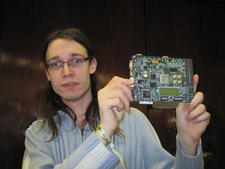26C3: Milkymist Visual Synthesizer Soon with Ethernet and USB
Initiator and main developer of the Milkymist project, Sébastien Bourdeauducq, showed a prototype of his visual synthesizer at the latest Chaos Congress and builds his own board for it.
Bourdeauducq describes his one-and-a-half-year-old system on a programmable chip (SoPC) as "eye candy on a chip." The board shown in a schematic diagram, with a soc-lm32 CPU, FPGA and floating-point coprocessor, visualizes audio input and renders its moving images over VGA. The name Milkymist comes from Bourdeauducq's association with MilkDrop, a visualization plugin for the Winamp audio player.
In his talk at the Berlin conference he covered how he solved the speed and RAM capacity problem with a minimum of expense. For a rate of 30 pictures per second at 1024 x 768 pixels, the texture mapping unit (TMU) needed to process 24 million pixels. Because memory, according the SoaC designer recently graduated in Sweden, depends on intelligent controller programming, he lets it gather into four memory chunks (a "burst") before releasing it, instead of one chunk at a time. His studies revealed that field-programmable gate arrays (FPGAs) are hugely underrated -- they're easy to obtain and dependable, but underused.
 With his Milkymist platform Bourdeauducq wants to provide visual jockeys (VJs) with "MilkDrop-esque" effects as a compact SoC.
With his Milkymist platform Bourdeauducq wants to provide visual jockeys (VJs) with "MilkDrop-esque" effects as a compact SoC.
The first prototype of his SoC was based on the $500 Xilinx ML401 board, which ran Linux kernel 2.6.23 and simulators such as Verilog with GPL Cver. Mid-2009 he presented his visualizer at the Hackerspace Festival in Paris. Since two months it now he is building his own board, which Bourdeauducq gave Linux Magazine Online a glimpse of.
The new board, which has a smaller footprint, processes audio and video input and have an Ethernet and USB interface. The Frenchman wants to swap the previous CF memory card with an SD card. According to his November writeup, it should eventually run on µClinux. The previous software is available in source and binary versions as well as a Debian package.
 Bourdeauducq with his prototype of the visual synthesizer. Instead of the Xilinx ML401 board that normally runs soc-lm32, he designed his own, which also has USB and Ethernet ports.
Bourdeauducq with his prototype of the visual synthesizer. Instead of the Xilinx ML401 board that normally runs soc-lm32, he designed his own, which also has USB and Ethernet ports.
Motivation for the project was to produce a completely open system on the hardware side. The BeagleBoard was too closed for Bourdeauducq: it's based on the proprietary OMAP chip and some of the drivers are also proprietary. "Texas Instruments," he complains, "does its own boards and otherwise marketing, for inexpensively produced software."
Subscribe to our Linux Newsletters
Find Linux and Open Source Jobs
Subscribe to our ADMIN Newsletters
Support Our Work
Linux Magazine content is made possible with support from readers like you. Please consider contributing when you’ve found an article to be beneficial.

News
-
OpenMandriva Lx 6.0 Available for Installation
The latest release of OpenMandriva has arrived with a new kernel, an updated Plasma desktop, and a server edition.
-
TrueNAS 25.04 Arrives with Thousands of Changes
One of the most popular Linux-based NAS solutions has rolled out the latest edition, based on Ubuntu 25.04.
-
Fedora 42 Available with Two New Spins
The latest release from the Fedora Project includes the usual updates, a new kernel, an official KDE Plasma spin, and a new System76 spin.
-
So Long, ArcoLinux
The ArcoLinux distribution is the latest Linux distribution to shut down.
-
What Open Source Pros Look for in a Job Role
Learn what professionals in technical and non-technical roles say is most important when seeking a new position.
-
Asahi Linux Runs into Issues with M4 Support
Due to Apple Silicon changes, the Asahi Linux project is at odds with adding support for the M4 chips.
-
Plasma 6.3.4 Now Available
Although not a major release, Plasma 6.3.4 does fix some bugs and offer a subtle change for the Plasma sidebar.
-
Linux Kernel 6.15 First Release Candidate Now Available
Linux Torvalds has announced that the release candidate for the final release of the Linux 6.15 series is now available.
-
Akamai Will Host kernel.org
The organization dedicated to cloud-based solutions has agreed to host kernel.org to deliver long-term stability for the development team.
-
Linux Kernel 6.14 Released
The latest Linux kernel has arrived with extra Rust support and more.
